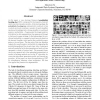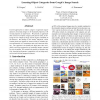893 search results - page 80 / 179 » Common-Frame Model for Object Recognition |
NN
2002
Springer
14 years 9 months ago
2002
Springer
Recognition-by-components is one of the possible strategies proposed for object recognition by the brain, but little is known about the low-level mechanism by which the parts of o...
102
click to vote
ICCV
2005
IEEE
15 years 11 months ago
2005
IEEE
In this paper, a new learning framework?probabilistic boosting-tree (PBT), is proposed for learning two-class and multi-class discriminative models. In the learning stage, the pro...
ICCV
2005
IEEE
15 years 11 months ago
2005
IEEE
Current approaches to object category recognition require datasets of training images to be manually prepared, with varying degrees of supervision. We present an approach that can...
NN
2008
Springer
14 years 9 months ago
2008
Springer
Learning data representations is a fundamental challenge in modeling neural processes and plays an important role in applications such as object recognition. In multi-stage Optima...
FGR
2006
IEEE
15 years 3 months ago
2006
IEEE
We present a novel tracking algorithm that uses dynamic programming to determine the path of target objects and that is able to track an arbitrary number of different objects. The...


